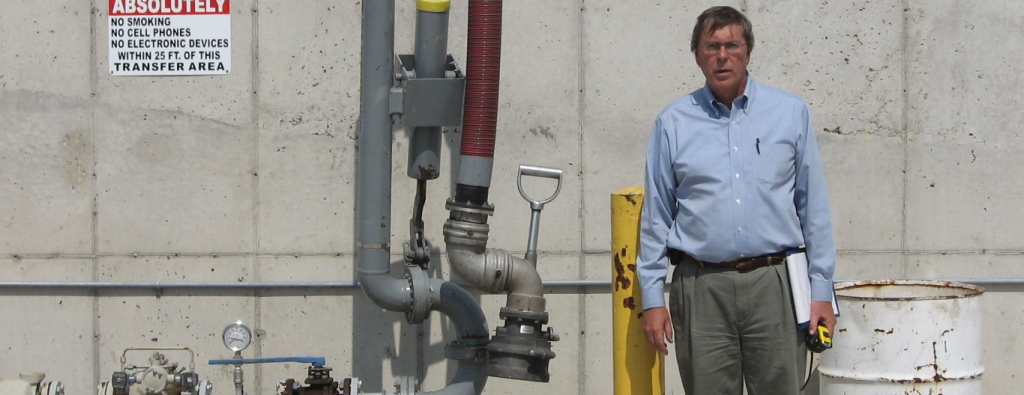All
Blend With Care

Bulk plant operators can prevent fuel quality issues, avoid downtime and even reduce insurance premiums by attending to the details of fuel blending and storage, according to Brian Savage, President of Savage Associates, specialists in petroleum storage and distribution.
Plants that blend biodiesel with petroleum must be prepared to blend the fuels thoroughly and without any major difference in temperature, according to Savage. “The way to avoid problems is to not blend B100 into home heating oil when the temperature difference is greater than 20 degrees,” he explained.
“Bacteria is like a baby, and it needs food in No. 2 oil, so it loves to see warmth and water. The pour point on B100 can be pretty tough, so people heat it up to mix it. So you might have 70-degree biodiesel mixing with 40-degree No. 2 oil, and the water comes out so you have droplets floating, which leads to bacteria.”
Fuel and Water
Water in fuel seems to be a universal problem throughout the U.S., according to Savage. “It happens with ethanol too, because ethanol and water love each other. If you don’t clean out a tank that has been used for gasoline before you add ethanol, the water will attach to the ethanol, and now you have two inches of ethanol and water, and any vehicle you fill won’t even make it out of the driveway,” he said.
Savage said the formation of stringy solids in petroleum-biodiesel blends, which has been reported periodically in recent years, is likely attributable to off-temperature blending. “A friend of ours in the oil business had a problem a few years ago when he blended 80-degree biodiesel with home heating oil. He had nearly 80 calls from people saying that they had run out of fuel, and what had happened was a slime formed that stuck to everything like witches hair and caused clogging,” Savage explained.
“It was all because of the temperature. Water is generated when two different density products are mixed and there is a temperature difference between the two. You will have a problem of generating microcosms in the water.”
To create stable mixes of petroleum and biofuel, operators must use a static in-line blender downstream of where the two fuel lines meet, according to Savage. The blender creates turbulence and emulsifies the fuels so that a complete mix occurs. He recounted an incident with a customer who received a barge load of diesel that had been blended with 2 percent biodiesel. The fuels were incompletely blended, and the B100 separated and settled to the bottom of the tank. When they started dispensing loads from the rack, the first fills were 50 percent biodiesel. “That had to do with how it was blended when they put it in the barge,” Savage said.
One of the worst things a fuel company can do is to rely on sequential splash blending of petroleum and biodiesel, according to Savage. “People assume the fuels will blend, but they don’t,” he said.
Tank Heating
To store B100 properly and maintain a workable pour point in all conditions, companies need a tank that can be insulated and equipped with an insertion heater, a heat exchange system or another type of heater. Lines that carry B100 must be heat-traced and insulated, as should the pumping station, the blend control system and other fuel handling equipment.
Plant operators should also be prepared when they handle Ultra Low Sulfur Diesel (ULSD), because it is a very dry product with lots of static electricity, according to Savage. Pipeline operators don’t want untreated ULSD in their pipelines because it can’t move eight-and-a-half feet per second with generating static charge. With all the static electricity, a lubricity additive is needed to cut down on friction, and biodiesel is a popular choice.
Savage also recommends that bulk plant operators be vigilant about maintenance and keeping their equipment up to date. One mistake he sees all too frequently is a failure to update obsolete equipment. Some bulk plant operators will let equipment run until it fails, only to find out that no one stocks the replacement parts because the equipment line has been discontinued.
He recommends that owners survey their plant equipment and bring it up to date so that everything can be serviced and repaired as needed. “Before you go into the heating season, know what equipment you have in your plant,” he said. “Know what equipment you have, and have it in writing. Have a company that is familiar with your plant come in and survey it and let you know what the problems might be.”
Mind the Rules
Companies with bulk plants should also know all the pertinent regulations to avoid compliance issues with fire inspectors or the U.S. Occupational Safety and Health Administration (OSHA). “I have seen plants where people still jump from the platform onto the top of the truck. What do you do if he slips and falls?” Savage said.
One potential benefit of regular bulk plant maintenance is that companies can reduce their insurance premiums. He said he knows one fuel dealer who regularly updates his bulk plant equipment and then invites his insurance company to come and inspect the improvements. “He tells them, ‘I don’t expect my premiums to go up,’ and it works,” Savage said.
Insurance companies tend to make assumptions about bulk plants, so it makes sense to request an inspection after making equipment upgrades, Savage said.
Related Posts
 Why Quality Matters in Your Biofuel Blends
Why Quality Matters in Your Biofuel Blends
Posted on June 25, 2025
 Incorporating Higher Blends of Biofuels
Incorporating Higher Blends of Biofuels
Posted on May 14, 2025
 NORA Programs at Eastern Energy Expo
NORA Programs at Eastern Energy Expo
Posted on May 13, 2025
 March Short-Term Energy Outlook
March Short-Term Energy Outlook
Posted on April 28, 2025
Enter your email to receive important news and article updates.
